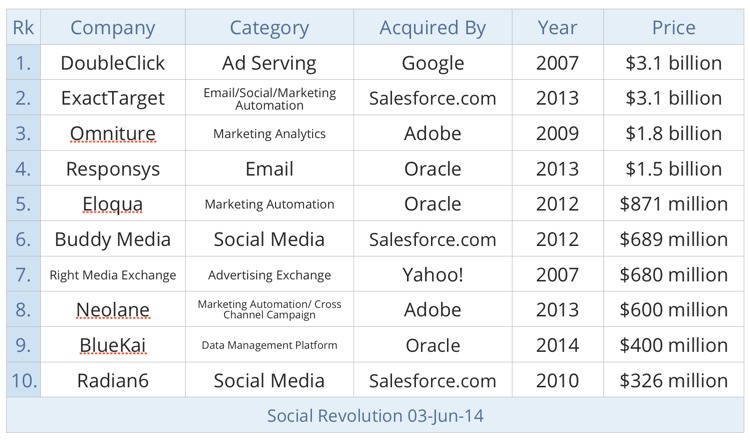This is even more remarkable when you consider there are more than 1,000 marketing technology vendors out there (see graphic above). Despite the abundance of innovative players in the game, my own experience with state-of-the-art marketing tools suggests there’s still a great opportunity to set a newer, better standard.
Unfortunately for those budding entrepreneurs, there is precious little data to suggest how big the digital marketing industry really is. What we do know, however, is that the value of the top 10 digital marketing acquisitions has already topped $13 billion:
 Digital marketing acquisitions have= already topped $13 billion.
Digital marketing acquisitions have= already topped $13 billion.
The feeding frenzy is largely caused by two fierce market rivals, Oracle and Salesforce.com, which between them are responsible for six out of the top 10 deals. To put this one-upmanship in perspective, despite having already spent more than $4 billion on marketing tech companies, Salesforce.com reported during its last earnings call that its Marketing Cloud generated $81 million in revenue during its fiscal third quarter alone.
Reality: Marketing Is Becoming More Difficult
The bigger picture here is that marketing as a discipline is under intense pressure to produce better results with less money. An inkling of this trend can be found in IDC’s 2012 Tech Marketing Barometer, which discovered that marketing budgets only increased by about 3.5% on average, despite expectations of an 8% increase.
IDC’s conclusion: Marketing budgets are getting tighter and marketers are expected to support larger businesses with relatively fewer resources. This is a worrisome trend, given how America’s corporate profits just reached another all-time high, as analyst Henry Blodgett recently observed.
With CMOs under the gun to produce more with less, they’re investing in new technologies while simultaneously squeezing more ROI from their marketing budgets in a push to cut overhead costs.
The same trend that’s transforming factory floors — robotics — is poised to reinvent marketing. Marketing automation software (MAS) or platforms (MAP) help marketers squeeze more efficiency out of the marketing process.
Despite the promise of these platforms, the reality is that 70% of respondents to a DNN Software survey report that marketing has become more challenging despite all the technology solutions available.
Upside: Market Opportunities
The technology sector is as crowded as ever, but thanks to the confluence of marketing trends, it still pays to be a vendor that can add to the bottom-line. Here are some digital marketing sectors of note:
- Advertising: One indisputable trend is that traditional marketing is giving way to digital marketing. While global ad spending will reach $543 billion in 2014, digital advertising will approach $133 billion this year.
- CRM: You would be hard-pressed to find another marketing segment with a rosier forecast than CRM. This past July, Gartner boosted its forecast predicting that the CRM market would exceed $36 billion by 2017, up from $28 billion in 2014. The reason is simple. CRM is the digital marketer’s address book, and all marketers need to grow their contact list. Yet, as I have already observed, the CRM arena is ripe for truly innovative solutions.
- Marketing automation: Frost & Sullivan reported this February that the marketing automation sector generated revenues of $551 million in 2013 and is poised to reach $1.9 billion in 2020. Their analysis shows that almost half of the market in 2013 was dominated by three competitors: Eloqua, Marketo and Silverpop, with more than 80% of the activity concentrated in the U.S.
- Social marketing: In 2011, IDC reported that social marketing represented just 1.3% of overall marketing spending but was a growing focus for tech companies. That same year, Forrester predicted that spending on enterprise social marketing software would reach $6.4B by 2016. Both of these early predictions are likely to have been more than fulfilled, based on the runaway ad growth at Facebook and Twitter.
Building the Stack
As mentioned before, there’s a huge opportunity to create a new standard in marketing software. With more than 1,000 companies in 40+ categories populating the “marketing technology landscape” (according to Ion Interactive’s Scott Brinker), one can only assume that marketers are simply too inundated with marketing tools.
Having experienced a host of of the best-of-breed tools — including AdRoll, AdEspresso, HootSuite, InfusionSoft, Moz, Qwaya and SproutSocial — it’s clear that marketing vendors need to pay more attention to the user experience.
This is all the more critical given that the No. 1 challenge in social marketing analytics is staffing, funding or resources, at 55%.
This has many thinking about a single, integrated solution that encompasses a broad set of marketing tools — or a “stack,” in industry parlance. An all-purpose solution like this would feature an architecture that could accommodate future needs and applications.
Another phenomenon that stands in way of growth is ad techn’s narrow-minded focus on large enterprises. Yet, as Act-On CEO Raghu Raghavan notes, only 3% of mid-market companies have adopted automation software. And, by his reckoning, this segment counts some two million companies that represent roughly $6-8 billion in revenue.
So here are your marching orders: Build an innovative marketing stack, or suite, and target the small to mid-sized business market and you too could sell your company to Oracle or Salesforce.com for hundreds of millions. Talk about stacking the deck in your favor.
